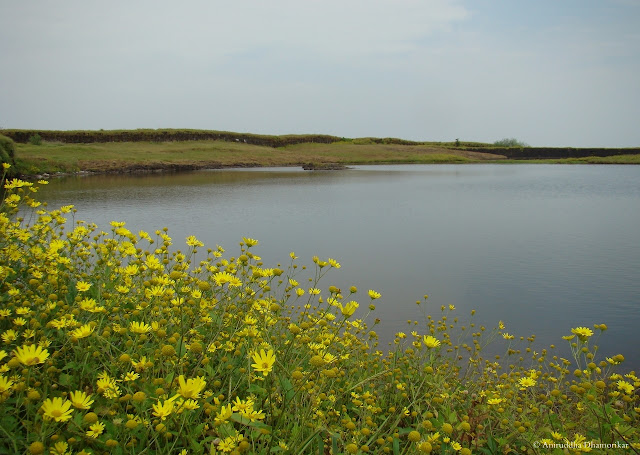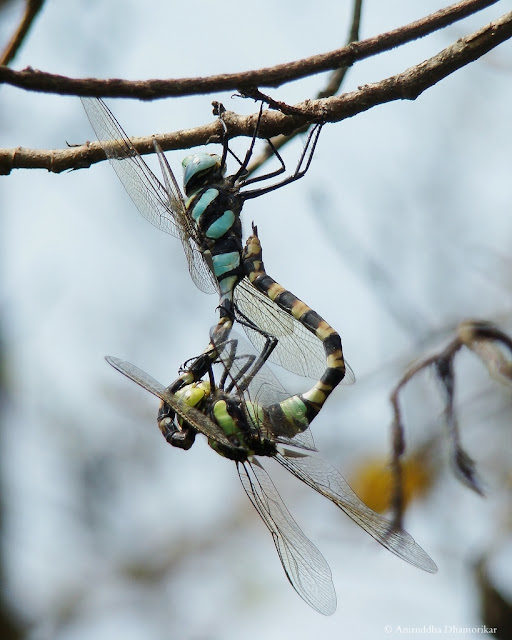Monsoon officially came to an end with the end of September. What didn’t come to an end was the sheer variety of plants and animals that were born in this season. They grew through the rich season and became adults, and these adults mated and either sowed seeds or laid eggs. The tiny embryos will lay dormant until March, which is a short but amazing season with soaring temperatures and surprisingly diverse flora and fauna – also called
Vasant Ritu (that is Spring), while some will wait for their time to come until next monsoon showers bathe the grounds.
 |
| Korigad |
I did a fair bit of explorations in October, of which I already talked about
Bhimashankar Wildlife Sanctuary. I also trekked Korigad in Pune district, Karnala Fort in Raigad district and Yeoor Hills in Thane district. This is quick glancing-though of the observations made in this season. I’m also spending more time on Monsoon Trails 2011Report, and therefore this post will be short and full of names.
October is a great month if you can brave the hot and humid weather. But this year, October was something else. It was rather cool and pleasant, and the post-monsoon showers lasted well into its mid week. On my very first visit to Korigad, we were glad to have seen the largest orchid of Mumbai:
 |
| Pectilis gigantea, the Butterfly Orchid |
This is Pecteilis gigantea, indeed a giant orchid with beautifully designed flowers carrying a subtle sweet scent. It is also called Butterfly Orchid. We saw them in the distance, thinking at first that they were ornamental Lilies that accidentally grew in a marshy land near a farm, but our curiosity told us otherwise. When we went in for a closer look – we were spellbound by its beauty and aroma.
 |
| Pogostemon deccanensis inflorescence |
We also saw flowers of Kempfiera scaposa, Chlorophytum glaucum, Smithia purpurea, Vigna vexillata, Dinetus racemosus, Exacum sp., Pogostemon deccanensis on the plateau, Celocia sp., and Senecio grahami. This was in the first week of October, however, and by the second week, half of them had vanished. At Karnala, we only saw flowering Barleria sp., Belpharis sp., Conscora diffusa, and flowering grasses such as Arundinella and Coix, amongst others.
 |
| Dendrobium buds |
In the third week I visited Bhimashankar, where I barely noticed any plants except for S. grahami. In the fourth week I visited Yeoor Hills, where we only saw flowering Urena lobata, a number of flowering grasses, and, budding Dendrobium orchids which will have flowered by now. Obviously I owe all these identification to my genius friends who can never fail to notice a plant and not know its identity.
 |
| Deciduous forests of Yeoor Hills |
Today as I sit and write this, I look back at the wet and dry treks – at the change in the landscape that was has been cyclic and timely for over million years. Even in this era when the anthropogenic impacts on the environment has been most severe, the change of seasons and the cycle of life and death associated with is has remained more-or-less same – albeit at a far smaller scale. We don’t – and we won’t – see these changes in the cities anymore. One will have to go deep into the forests and over the plateaus to observe them.
 |
| A Dung Beetle frenzy! |
The animals that are closely associated with the plant were also very diverse. We saw a number of Beetles in the family Melyridae, several Clinteria sp., and Dung Beetles in the family Scarabaeidae, a Menochilus sexmaculatus in the family Coccinellidae, some unidentified Leaf Beetles in the family Chrysomelidae, a member of Buprestidae – also called Jewel Beetle, as well as beetles in family Dytiscidae.
Amongst Lepidoptera, the most dominant species was Danaid Eggfly:
 |
| A male Danaid Eggfly sipping nectar from Celocia |
These butterflies are territorial, with the males furiously defending their territories from other invading males, and are the commonest ones to observe the hill-topping behaviour. During the latter half of monsoon months, when their populations increase, the males occupy the top of the forts, where they compete with other males for space. The females, however, are always uncommon to observe at such a height.
The most diverse in this season belonged to the family Hesperiidae – from the omnipresent Chestnut Bobs, to Common Small Flat, Brown Awl, Conjoined Swift and a Suffused Snow Flat (seen at Korigad) were all seen defending their territories as well. This is the season of love, after all, and they better have their own space!
The Odonates were also equally common. I saw more and more of Damselflies by the end of September and in October than in the peak monsoon months. One of my favorite is a Black-winged Bambootail:
 |
| A male Disparoneura quadrimaculata |
This damselfly was observed at Yeoor Hills, where they inhabit steadily-flowing streams. This male, as well as two females, were observed near a temporary dam built by villagers deep inside Yeoor Hills.
 |
| Anax immaculifrons in Wheel formation |
Other’s that were present were Pseudagrion rubriceps, Ceriagrion coromandelianum, Vestalis gracilipis, Lestes sp., as well as dragonflies such as Gynacantha bayadera, a mating pair of Anax immaculifrons, Luicozum sp., and several pairs of Neurothemis aurora.
Of all the creatures, the most abundant were, undoubtedly, the Hymenopterans. One of my favorite in this season was a really colourful Bracronid Wasp:
 |
| A beautiful Braconid Wasp! |
This wasp, probably in the genus
Callibracon, was seen at Yeoor Hills, where she was inspecting a fallen tree for any traces of beetle grubs. I’ve already talked about a similar behaviour in
this post. That really long ovipositor can pierce through the wood, and inject an egg on-or-near a grub with precision. Amongst others, I saw a number of Crabrionid wasps, Oriental Hornets feeding on Honeybees at Korigad, as well as a beautiful Velvet Ant in the family Mutillidae at Karnala Fort.
Amongst ants the most common this time were
Tetraponera rufonigra – a winged queen (at Korigad) as well as dedicated workers in all the three places.
 |
| Worker Oecophylla smargdina at play! |
Also common were the worker
Oecophylla smargdina (photographed above), whose Winged Queen and a mated Queen we saw last month. We stumbled across a nest of
Leptogenys sp.
(processionalis) at Korigad.
The fly population hasn’t gone down, but the families that were more common in monsoon are now less in numbers, and the ones that exclusively feed on flowers are more in numbers – such as those in the family Syrphidae, as well as some members in the family Sepsidae that are more commonly seen on dung.
One of the key sightings was that of a Robber fly laying eggs in the inflorescence of grass (pictured above). Their eggs are laid in a bunch of several hundreds - and look like a frothy conglomeration.
 |
| A Robber fly laying eggs |
Spiders, from the tiny Jumping Spiders to the giant, Giant Wood Spiders were also seen. The above photograph is that of a male in a female Nephila’s web. She was busy feeding and this tiny male was stalking her.
 |
| A male stalking a female Nephila |
Amongst reptiles, we saw the largest gecko of northern Western Ghats - Hemidactylus maculatus - both male and a female, at Karnala Fort:
 |
| A male and a female Hemidactylus maculatus |
This time, we also did some bird-watching! And saw a Common Kestrel, Peregrine Falcon and an Oriental Honey Buzzard.
 |
| The Oriental Honey Buzzard of Karnala |
And so we come to the end of Monsoon Trails! I could not write much today. But I thought I would give a glance of how diverse October is. I hope to return with more interesting stuff soon. The Monsoon has retrieved for good, and I hope it comes back on time next year. And with the end of Monsoon, I now declare the beginning of Winter Trails! Winter is just a name-sake season here on the Coastal plains. It’s almost like the beginning of summer for us. But it is also a fantastic season to observe migrating animals (mostly birds) that come down south to overwinter.
A pleasant read Ani...nice work! :)
ReplyDeleteI'm fascinated by the Pectilis gigantea! Do you have any photos of the whole plant?
ReplyDeleteHow different and yet similar October seems to be for both of us! I just blogged about October in my garden in Mumbai city some days ago. It is buzzing with activity too!
Das sind Raphael und YvonneNovember 11, 2011 at 5:41 PM
Hi,
ReplyDeletewonderful pictures and story! So many flowers, thats amazing!
I do like to see also the smallest creatures like insect..
And the landscape looks really pleasant!
Greetings and have a nice weekend
Yvonne and Raphael
Thank you everyone for visiting! :)
ReplyDeleteGood work Aniruddha! We all are proud of you!
ReplyDeleteDon't forget - we have to plan our chiplun visit :)
Gauri